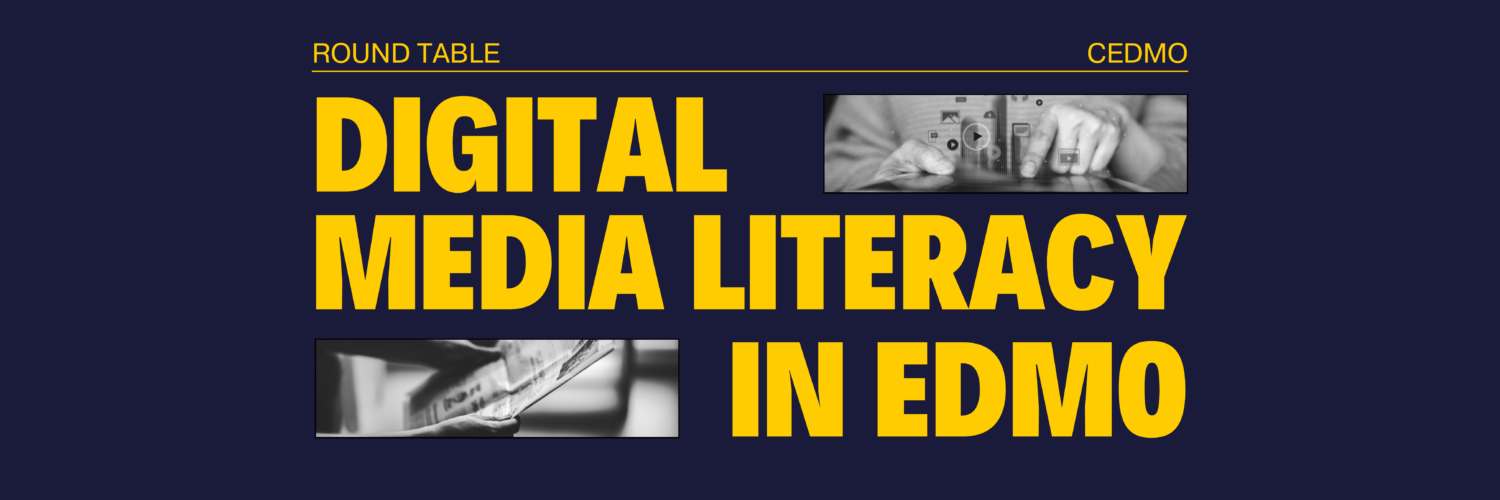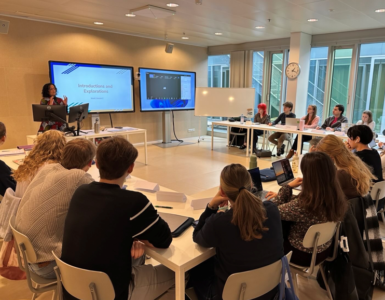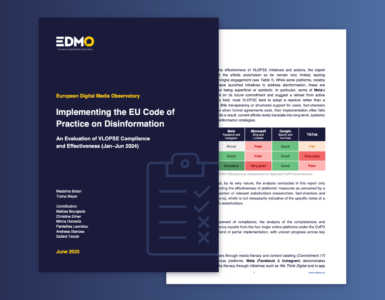This interview is part of the ”Digital Media Literacy in EDMO Round Table’‘ interview series that is published every month to highlight the work of the 14 EDMO hubs.
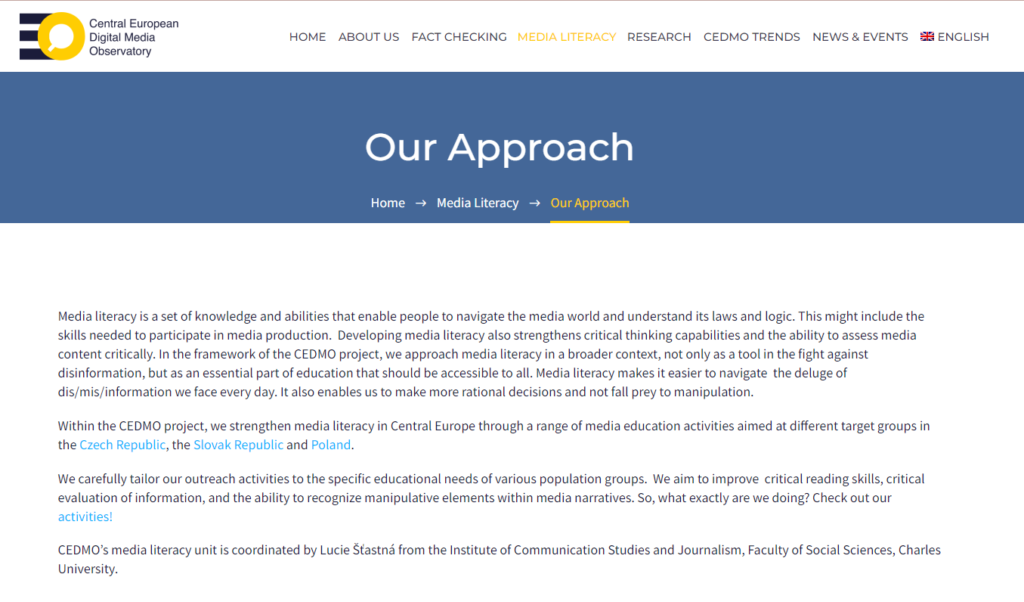
CEDMO, Lucie Šťastná, Institute of Communication Studies and Journalism at Charles University, Prague, Czech Republic; Viera Kačinová, Faculty of Mass Media Communication, University of St. Cyril and Methodius, Trnava, Slovakia; Karina Stasiuk-Krajewska, SWPS University of Social Sciences and Humanities, Poland.
Who are the leading players in the CEDMO region (Czechia, Slovakia and Poland) when it comes to promoting media literacy?
Lucie Šťastná: The situation in the individual countries involved in the CEDMO project is a little different. As far as the Czech Republic is concerned, there is a lack of significant state support for the development of media literacy. Although media education is still part of the compulsory curriculum, it is up to teachers and schools how much space they devote to it. Curriculum documents have also been revised for several years, and media education does not have a very strong position in these discussions, so the question is what form it will take in the future. Due to the not too great interest of the state, universities and non-profit organizations are becoming the key players in the development of media literacy. In particular, university experts from Prague’s Charles University (Faculty of Social Sciences), Brno’s Masaryk University (Faculty of Social Studies) and Olomouc’s Palacký University (Faculty of Pedagogy) strive for basic research in this area, but also for media education in practice. For example, students of the University of Brno founded their own media education project Zvolsiinfo, which helps young people navigate the media and recognize disinformation. The Olomouc team, on the other hand, is made up of experts and doctoral students who are trying to educate on current issues related to media education – e.g. security issues, disinformation, and most recently artificial intelligence.
Among the Czech non-profit organizations, the strongest player is probably One World in Schools, a project of the non-profit organization People in Need, which organizes conferences, training sessions and creates didactic materials, as well as, for example, campaigns such as Media Education Weeks. In addition to this large organization, however, there are many small non-profit organizations that together will also do a great job, they may be targeted at specific target groups (e.g. the Elpida non-profit organization providing education for seniors) or topics (e.g. Faketicky focusing on the education of children and teachers). Moreover, the private sector (e.g. Seznam.cz) or various foundations are also involved in supporting the development of media literacy (e.g. the O2 Foundation supports projects focused on internet safety, The Kellner Family Foundation implements projects supporting critical literacy and critical thinking through reading and writing).
Viera Kačinová: One of the main institutional actors in the development of initiatives and activities in the field of media literacy in Slovakia is currently the Council for Media Services, the national regulator for audiovisual media services, which is legally competent in this area. Also in view of the obligation to submit a regular overview report to the European Commission on activities aimed at promoting media literacy in the country, it is in its interest to monitor the activities of various organisations in this field. The key actors arebrought together in “The Media Literacy+ Platform“, which the Council also initiated in 2023. It is made up of institutional and personal experts from various sectors of society, from academia, government institutions and the third sector, who are actively engaged in the topic. The Platform also serves as a tool for coordinating and promoting greater cooperation between the different segments. In the academic environment, the Faculty of Mass Media Communication of the University of St. Cyril and Methodius in Trnava, which has set up the International Media Literacy Centre as well as the Internet platform www.medialnavychova.sk for this purpose, has been developing long-term and systematic initiatives in the country aimed at the development of media literacy among a broad target group. It is also the only one in Slovakia to offer a separate accredited study programme at three levels of higher education focused on media education, and thus comprehensively prepares professionals in this field. Among the state institutions, it is mainly National Institute of Education and Youth which is responsible for curriculum anchoring of media education within school education and implementation of supporting educational programmes for teachers in this field. There is also an extremely active civil society sector in the country at the moment. To name but a few are the initiatives of the institution for promoting digital citizenship “Digital Intelligence – digiQ”, or „Zmudri.sk“ and its video courses for schools, teachers and students, focusing on several areas of media education, specifically promoting the development of critical thinking.
Karina Stasiuk-Krajewska: As for the situation in Poland, the leading players are NGOs (for example Demagog), professional associations (for example the Polish Association of PR) and also local government units.
Do you have any ideas as to how media-literate people in this region are generally? Are there any types of measures that can be used to assess this over time?
Lucie Šťastná: If I were to start again, several studies were conducted in the past in the Czech Republic mapping the media literacy of the Czech population. The Radio and Television Broadcasting Council has the main initiative in this, as it is its duty by law. Thus, once every 5 years (so far 2011, 2016 and 2021) it commissions research monitoring various areas of media literacy, unfortunately in each of the years mentioned the analysis was carried out by a different team of researchers in a slightly different way, so the results are difficult to compare over time. The results of the latest research from 2021 show that the level of media literacy of the population over 15 years old reaches the number 49 out of 100. Researchers from the Palacký University in Olomouc and the Stemmark agency created a point evaluation of the respondents’ answers so that they could calculate the total score. They monitored media literacy through 4 sub-areas, in each of which the scores differed: 1. Access and use of media (69.8), 2. Analysis and evaluation of media (52.5), 3. Reflection on media (56.0), 4. Production (21.1). It can be expected that the Council will repeat this research in 2026 and we will see how the Czech population has shifted again. In addition to research initiated by the Council, there are other sub-researches focused on media literacy, for example, on certain areas of media literacy or specific groups. For example, research by the Czech School Inspectorate (2018) focused on the media literacy of children in primary schools, and certain areas of the media literacy of teachers and pupils are also regularly monitored by research commissioned by the non-profit organization People in Need.
Viera Kačinová: In Slovakia, there is currently no comprehensive measurement of the level of media literacy of different target groups of the population, which would enable a relevant assessment of the situation. There is also a lack of systematic research in this area. However, surveys covering partial areas of media literacy development targeting specific groups are available. In the framework of the CEDMO project in cooperation with the IPSOS agency, surveys have been carried out on the perception of disinformation among the Slovak population in comparison with other countries of Central Europe especially the Czech Republic, but also the Baltic countries. Slovakia also participates in the international systematic research EU KIDS online through experts from the Catholic University in Ružomberok. They also covered specific research that followed up on the previous one. It focused on the experiences and behaviour of Slovak children and adolescents aged 9-17 years in specifically selected areas, in particular risky behaviour on the Internet, but also on the habits of this target group related to the use of the Internet. Slovakia, through the Broadcasting and Retransmission Council, also participated in an international project to assess the media competences of 14-18 year olds. The EduMediaTest was conducted in May 2021 and involved 8 699 pupils aged 14 to 18 from seven European countries. In Slovakia, 1317 pupils from seventeen schools took part in the testing. The results of international measurements in the form of the “Media Literacy Index” are also a certain, albeit methodology-specific, statement about the state of media literacy in Slovakia.
Karina Stasiuk-Krajewska: Studies conducted in Poland indicate a low level of media literacy and a low level of scientific knowledge in general. Eurostat surveys can provide data for comparison. It is also interesting to see how the presence of media literacy content in school curricula is changing (generally – there is very little of it in Poland, for example, there is no separate education path of media literacy).
What are the main challenges you face in promoting media literacy in these three different countries?
Lucie Šťastná: As for the Czech Republic, there are three main challenges in my opinion. Firstly, there is a lack of greater support for media literacy and greater cooperation between individual state departments on its support at the system level. There is a lack of a strategy for the development of media literacy, but also a clarification of which department or component of the state is actually in charge of the development of these competencies. This is then reflected in how media literacy is approached at lower levels of the system. So, secondly, media education in schools probably suffers the most from the fact that future teachers still cannot choose media education as their specialization, but that they can only complete partial courses related to media. They may also receive one-off training from non-profit organizations, the media or the private sector, but they do not systematically cover this area. In addition, everything depends on the activity and enthusiasm of the future or existing teacher and, at the school, also the director. Complications in the education of future media education teachers are manifested, for example, in the fact that many schools choose the easiest way – to invite a non-profit organization or a journalist to hold a one-off workshop or lecture for children, and thus the teacher/director has completed media education. But of course, that is not enough. Thirdly, the general challenge is also the constant updating of the imparted knowledge, because the subject of education – the media and the media landscape – develops so rapidly that it is very difficult to monitor and respond to in teaching (not to mention the official documents, which lag behind technological development ). But that will probably be a challenge for all teachers in the world, not just the Czech ones. And I am not talking about the challenges associated with the education of adults or specific target groups. There would certainly be enough of them.
Viera Kačinová: As indicated, the area of research in this field is currently a major challenge, but so too is the specification of indicators to enable the measurement and evaluation of the level of media competency for different target groups. Particularly at the level of individual school education levels, it would be desirable to define in more detail the binding objectives or outcomes of media education as a specific educational topic, which would serve as a starting point for testing. There is still a need for media education awareness among teachers and their training as a basis for more interest and also competence to teach it in schools. At the level of higher education, apart from the one case mentioned above, there are no study programmes in which future professionals can be more comprehensively trained, even in the faculties of education. At the same time, there is also a lack of a broader institutional framework that would systematically cover the development of media literacy among a wide group of individuals at regional level. For example, in the form of media literacy centres. Particularly the provision of education for parents and tools to increase their media competence is a special need in Slovakia.
Karina Stasiuk-Krajewska: The main challenges are the lack of specialists in schools; the lack of education programs in this area; the low level of confidence of Poles in traditional media and in science. Activities in this area in Poland are chaotic and uncoordinated, administered mainly by NGOs. Educational institutions do not have specific program guidelines in this area. The problem is also the low motivation of teachers for self-development – due to the large number of responsibilities they have, and low pay.
What value do you think EDMO and the network of EDMO hubs in particular bring to the challenge of fighting disinformation and promoting media literacy in this region?
Lucie Šťastná: The added value is certainly that researchers and experts who deal with the topic in individual countries and try to research the topic and create media-educational mixes tailored to the population of their country can exchange experiences and know-how, can discuss current challenges or collaborate on other international research or educational activities. Together, they also create more power and have more weight, so they can lobby more for the promotion of media literacy at the level of the European Union, and this is also not an insignificant role.
Karina Stasiuk-Krajewska: First of all, the cooperation of different communities. We observed that teachers find training with fact-checkers, for example, attractive. On the other hand, the fact-checker community in Poland is open to training other groups. The value is also the opportunity to compare with other countries, especially to be inspired by existing solutions there.
What types of media literacy activities have been organised by CEDMO since it was set up?
Lucie Šťastná: We have already created a lot of media education events and materials, as we are four teams involved in media literacy. We created different learning opportunities in each participating country to meet the needs of the population in that country. For example, in the Czech Republic, we focused on teachers and journalists and prepared lectures in present and online form for them as well as the handbook for its participants.
Viera Kačinová: The Slovak team organised a course for teachers and online courses for primary and secondary school pupils and also a competition for teachers where the examples of best practice in media education related to disinformation were rewarded. We also gathered information on educational projects focused on online disinformation in the Slovak environment. The aim was to prepare an overview of relevant projects and their publication in a research study.
Karina Stasiuk-Krajewska: The Polish team launched a podcast serie “Contexts of disinformation” and has already published almost all 10 episodes of this podcast. There were also 2 webinars for teachers and a handbook created for Polish parents on how to talk about disinformation with their children. Before CEDMO 1 ends, we are planning some other events.
Lucie Šťastná: The last team we haven’t mentioned yet is AFP. This agency has prepared educational tutorials and quizzes for CEDMO focusing mainly on verification techniques, these short videos and two self-tests are available in 4 languages on the CEDMO website, where you can find more detailed information about the outputs of individual teams.
What plans do you have in relation to media literacy for the next 12 months for CEDMO?
Lucie Šťastná: There are only a few months left until the end of the project, so most teams have already completed their deliverables. It’s actually just a Polish team that has planned some more educational activities for the following months. Would you like to add some details, Karina?
Karina Stasiuk-Krajewska: Yes. It’s a special event for journalists and fact-checkers that we plan to hold in January 2024, followed by a webinar and workshop for teachers. The Polish team is also finishing two short educational videos targeting young people.
Lucie Šťastná: But even the teams that have already finished are not idle. For example, the Czech team continues to prepare and organize lectures for teachers, in which they try to newly focus more on topics related to artificial intelligence in education. They also wants to focus on this and on adapting lectures for other target groups in a possible follow-up project to CEDMO. The Slovak team, together with the Czech team, continues to collect data for the media educational repository, which is also an example of an initiative that should continue in CEDMO 2. In CEDMO 2, however, we have also planned a number of new educational activities, with which we cover areas and target groups that we have not yet addressed. So hopefully luck will favor us and CEDMO 2 will become a reality.
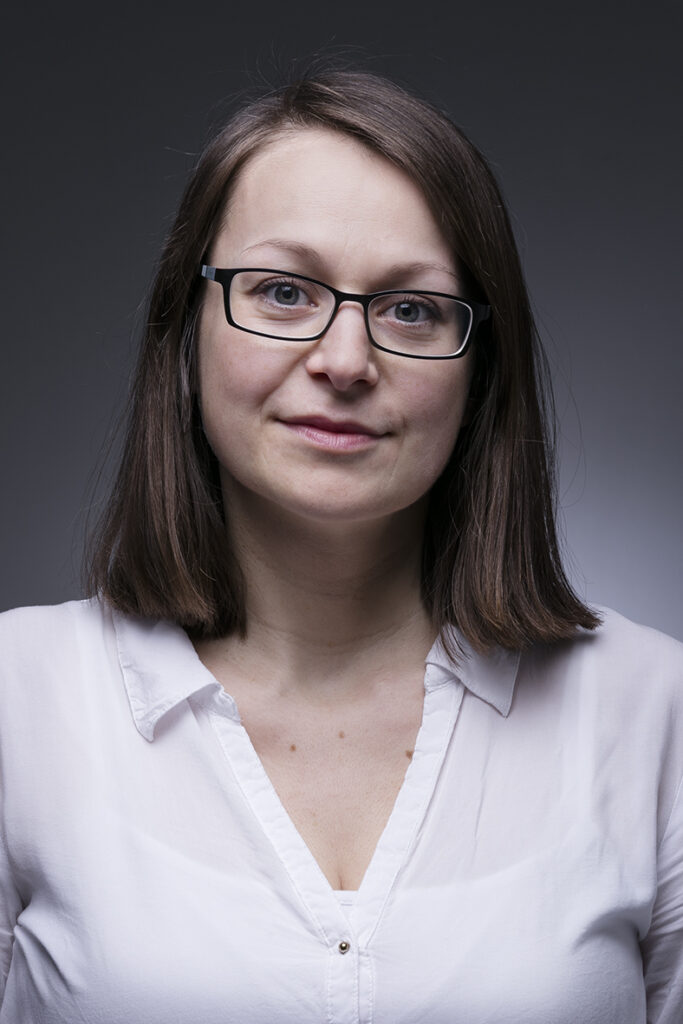
Lucie Šťastná, Researcher, Institute of Communication Studies and Journalism at Charles University, Prague, Czech Republic & leading the Media Literacy team in CEDMO.
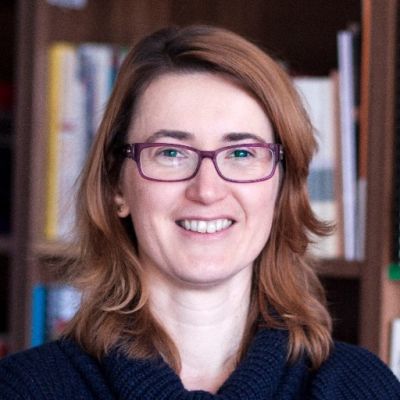
Viera Kačinová, Faculty of Mass Media Communication, University of Ss. Cyril and Methodius, Trnava, Slovakia

Karina Stasiuk-Krajewska, SWPS University of Social Sciences and Humanities, Poland & leading the Media Literacy team in Poland.

